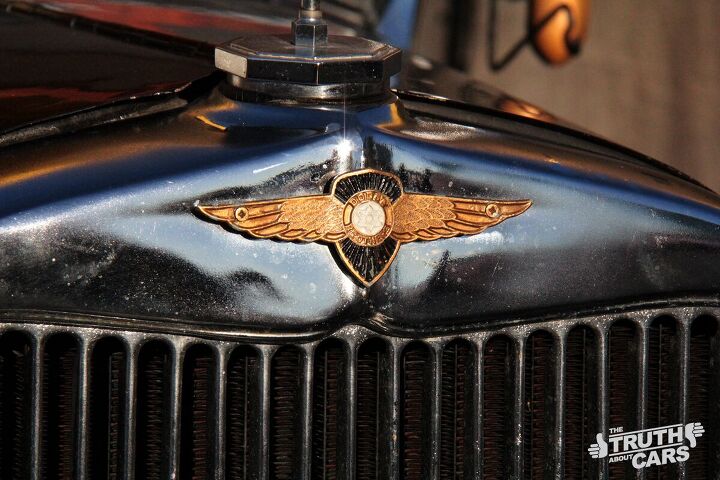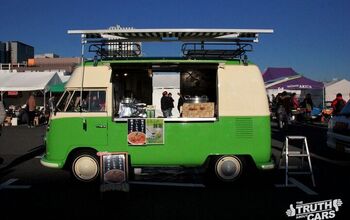Reporting From The Concoures D'eregance In Tokyo: The Americans In Japan

Today, I was in Odaiba, the man-made island in Tokyo Bay. The island is known for its futuristic buildings. Today, it was home of the Japan Classic Car Association’s New Year Meeting. It celebrates the imported car. During the next days, I will show you the nicer ones. We start with the Americans, and a Dodge.
The tonier places in America, like Pebble Beach and Hilton Head, are known for their Concours d’Elegance, something the organizers wanted to bring to Tokyo. It looks like it was damaged in transit.
Some of the first cars in Japan were American, just like this early Dodge Brothers model. The first car made in Japan, in 1902, was powered by a gasoline engine, hand-imported from the U.S. by Komanosuke Uchiyama. Five years later, he produced the first entirely Japanese-made car.
Detroit pretty much owned the Japanese car market before the war. Ford, Chrysler, and General Motors all had production plants in the island nation. Between 1925 and 1936, the Big Three produced 208,967 cars in Japan. Japanese automakers, and there were many, made only 12,127.
Cars imported to Japan, mostly from America and England, did set the style for Japanese cars.
After the war, American makers liked to use their British subsidiaries to export cars to Japan. This is the egg crate grille of a Nash Metropolitan Roadster, built between 1953 and 1961 at Austin’s Longbridge plant.
Except that this Nash has the steering wheel on the left. Must have been the export model.
This is a Ford Prefect, built in the UK.
It looks like the 100E (1953 to 1959). Its steering wheel is at the right left, I mean, it was left at the right side. Next to the Prefect sits a BMW 2002, the predecessor of the 3-series. I had one of those, also in Bavarian Blue.
Wedged between a Porsche and a Triumph, a Shelby GT350. When this car came to Japan, the glory of American imports in Japan began to fade, and the Europeans took over. We will look at them tomorrow.

Bertel Schmitt comes back to journalism after taking a 35 year break in advertising and marketing. He ran and owned advertising agencies in Duesseldorf, Germany, and New York City. Volkswagen A.G. was Bertel's most important corporate account. Schmitt's advertising and marketing career touched many corners of the industry with a special focus on automotive products and services. Since 2004, he lives in Japan and China with his wife <a href="http://www.tomokoandbertel.com"> Tomoko </a>. Bertel Schmitt is a founding board member of the <a href="http://www.offshoresuperseries.com"> Offshore Super Series </a>, an American offshore powerboat racing organization. He is co-owner of the racing team Typhoon.
More by Bertel Schmitt
Latest Car Reviews
Read moreLatest Product Reviews
Read moreRecent Comments
- Lichtronamo Watch as the non-us based automakers shift more production to Mexico in the future.
- 28-Cars-Later " Electrek recently dug around in Tesla’s online parts catalog and found that the windshield costs a whopping $1,900 to replace.To be fair, that’s around what a Mercedes S-Class or Rivian windshield costs, but the Tesla’s glass is unique because of its shape. It’s also worth noting that most insurance plans have glass replacement options that can make the repair a low- or zero-cost issue. "Now I understand why my insurance is so high despite no claims for years and about 7,500 annual miles between three cars.
- AMcA My theory is that that when the Big 3 gave away the store to the UAW in the last contract, there was a side deal in which the UAW promised to go after the non-organized transplant plants. Even the UAW understands that if the wage differential gets too high it's gonna kill the golden goose.
- MKizzy Why else does range matter? Because in the EV advocate's dream scenario of a post-ICE future, the average multi-car household will find itself with more EVs in their garages and driveways than places to plug them in or the capacity to charge then all at once without significant electrical upgrades. Unless each vehicle has enough range to allow for multiple days without plugging in, fighting over charging access in multi-EV households will be right up there with finances for causes of domestic strife.
- 28-Cars-Later WSJ blurb in Think or Swim:Workers at Volkswagen's Tennessee factory voted to join the United Auto Workers, marking a historic win for the 89- year-old union that is seeking to expand where it has struggled before, with foreign-owned factories in the South.The vote is a breakthrough for the UAW, whose membership has shrunk by about three-quarters since the 1970s, to less than 400,000 workers last year.UAW leaders have hitched their growth ambitions to organizing nonunion auto factories, many of which are in southern states where the Detroit-based labor group has failed several times and antiunion sentiment abounds."People are ready for change," said Kelcey Smith, 48, who has worked in the VW plant's paint shop for about a year, after leaving his job at an Amazon.com warehouse in town. "We look forward to making history and bringing change throughout the entire South." ...Start the clock on a Chattanooga shutdown.












































Comments
Join the conversation
I've always wondered why JDM cars are RHD. Given the historical precedence of American cars in the early JDM, I would have thought they would drive on the right like we do. Do any of the B&B know why?
And yet, there are a few LHD cars in Japan - some folks like them because they're different - a fair amount of BMWs and Mercs in Japan are LHD. Never mind that they have to use a long pole with a basket to pay highway and bridge tolls.